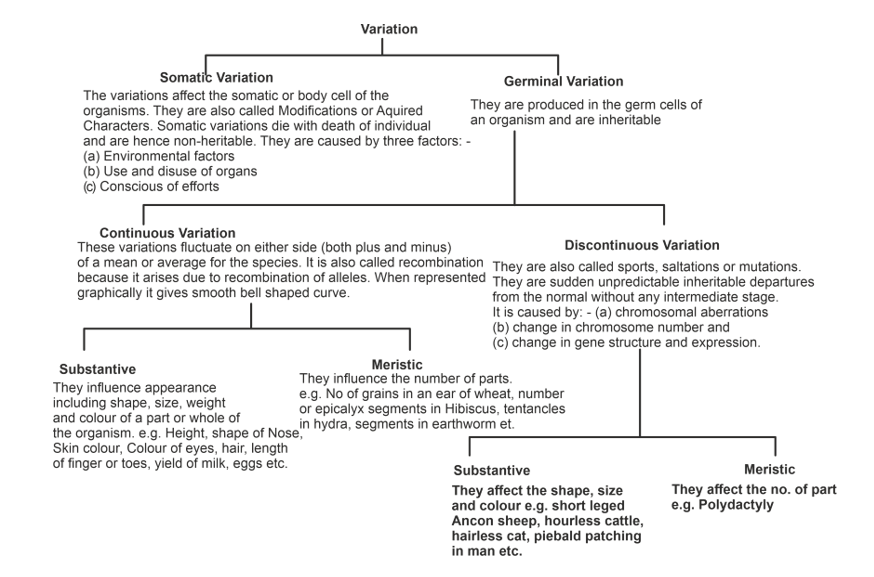
Introduction
Genetic Basis Of Inheritance of Class 12
The word Genetics was coined by an English biologist William Bateson in 1905 [regarded as Father of Modern Genetics. The word Genetics is derived from a greek word ‘gen’ meaning to become or to grow into. Genetics is the branch of biology which deals with the study of heredity and variation.
Heredity :- Transmission of characters from one generation to another generation is called heredity.For example, human babies are like human beings in over all characteristics. This has been summed up in the phrase ‘like begets like’.
Variation :- The tendency through which the organisms differ in specific ways from one-another is called variation. e.g. we can easily distinguish the members of a family, except the identical twins.
Variations appear in offsprings or siblings due to :-
- Chance separation or segregation of chromosomes at the time of gamete or spore formations
- Crossing over
- Chance combination of chromosomes during fertilization

Fig. Types of variations
PRE MENDELIAN IDEALS ABOUT INHERITANCE
- Moist Vapour Theory It was proposed by a Greek philosopher Pythogoras in 500 B.C. Vapours are emitted from the body of male and female and these vapours mixed at the time of sexual reproduction. So, offspring is blend of mother and father.
- Preformation Theory (1632–1723) Scientist Malpighi propounded the preformation theory. This theory holds that the sex cells (sperm and ova) had the miniature copy of adults called ‘homunculus’, and the development of embryo was actually only the enlargement of parts that were already present in the sperm or egg.
- Pangenesis Theroy Manperitus propounded theory of pangeneses. According to this theory every cell, of animal body produces many minute particles known as pangenes or gemmules. Term pangene was given by arwin.
- Theory of Germplasm August Weismann (1889) suggested the theory of continuity of germplasm. He referred to the reproductive cells as germplasm and to rest of the body as somatoplasm. The germplasm forms the bridge of life and passes from one generation to the next. In each generation it also produces the somatoplasm. Soma is ‘Mortal’ because it eventually dies and disintegrates, the germ is “immortal”, because it is continues forever. According to Weisman the germ cells have genetic units or determinates. He rejected the theory of pangenesis. Thus first time a proper distinction was made between heritable and environmental variation on the basis of this principle.
MENDELISM
Gregor Johann Mendel Mendel was born on 22 July 1822 at Heinzendorf in Austria. Mendel worked in Augustinian Monastry in Brunn, as monk. In 1856–57, he started his historical experiments of heredity on garden pea plant. [Pisum sativum] His experimental work continued on pea plant till 1865. The results of his experiments were published in the science Journal ‘Natural History Society of Brunn’ in 1866 entitled “Experiments on plant Hybridization” . Mendel died on January 6, 1884, due to kidney disorder.
Mendel’s work remain unnoticed and unappreciated for some 34-35 years due to :–
- His work was ahead of his time.
- He published it in a journal that had limited circulation.
- He was himself not sure of his findings, as he failed to get similar results on hawkweed (Hieracium).
- Mind of the biologists was pre–occupied with the Darwin’s theory of evolution.
Rediscovery of Mendel’s Work (the birth of Genetics)
It was in 1900 that three botanist independently rediscovered the principles of heredity already worked out by Mendel.
They were :–
- Karl Correns – Germany – Worked on maize (Zea mays).
- Hugo de Vries – Holland – Worked on evening primrose (Oenothera).
- Erich von Tschermak – Austria – Worked on flowering plants. Correns gave the two law of Mendelism – law of segregation and law of independent assortment. Hugo de Vries also found out the paper of Mendel and got it published in “Flora” in 1901. Bateson, Punnet and other subsequent workers found Mendel’s work to be of universal application including animals.









